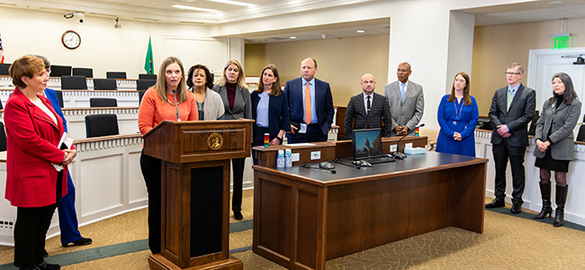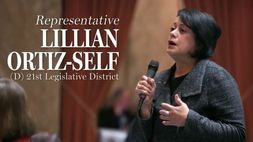Making our schools a safe place to learn
Our nation has experienced far too many tragic school shootings in recent years: Sandy Hook Elementary, Marjory Stoneman Douglas High School, Santa Fe High School, and more.
Washington has not been free of tragedies like these, including shootings at Freeman High and at Marysville Pilchuck High School.
Students need to be safe in schools, and they need to feel safe in schools. Those are the guiding principles behind a package of bills we introduced, that are focused on improving school safety and student well-being.

These bills focus on preventing youth suicide, increasing access to school guidance counselors, building regional safety support networks, improving student mental health services and training, and reforming school resource officer policies.
If you have a few minutes, I encourage you to watch this video of Alissa Parker, mother of Emilie Parker, one of the 20 children who died tragically in the Sandy Hook school shooting, tell her story at a recent school safety press conference. She shares her personal story in greater detail during the House Education Committee work session on school safety.
After her daughter’s death, Alissa has dedicated her life to sharing her story in hopes of changing school safety policies and practices in communities all over the country so that no parent will ever suffer the way she has from losing Emilie.
I look forward to working with my colleagues this session to make our schools are safer and improve student well-being.
Unfortunately, some lawmakers in Olympia want to address the school safety issue by arming teachers. I wholeheartedly reject this idea. Gun violence is not reduced by adding more guns to the situation.
My colleague Rep. Tana Senn said it best at the school safety press conference. Arming teachers with guns is not the answer. Instead, we should be arming teachers with information and skills around mental health, de-escalation training, and service referrals.

You can also watch my most recent video update where I discuss the issue of school safety and talk about the press conference. |
We have 74 Orcas left. That’s it. Only 74.
Our state’s official marine mammal, and a significant symbol for Native Americans in our region, our resident orca whale is on the verge of extinction. If we don’t do something to protect them now, pretty soon all the Southern Resident killer whales will be gone.

According to the recommendations by the Southern Resident Orca Task Force, three main culprits are causing the dramatic decline of our orca population: not enough food, and waters that are too polluted and too loud. Fortunately, the House is taking bold actions to save our whales with several bills sponsored by my colleagues, Reps. Joe Fitzgibbon, Debra Lekanoff, Beth Doglio, and Brian Blake: HB 1579 would increase habitat for Chinook salmon and other forage fish. By protecting their habitat, we’ll have more salmon, which is the orcas’ main food source. HB 1578 would reduce threats to Southern Resident orcas by improving the safety of oil transportation. HB 1194 would identify and reduce the largest sources of toxic chemicals, including phthalates, PFAS, toxic flame retardants, phenolic compounds, and PCBs that are polluting our homes and our waters. HB 1580 would require reduce vessel noise and disturbance near Southern Resident orcas. No one wants to see another dead calf carried through the Salish Sea by her mother for over two weeks. I strongly support all of these bills and trust that they will make a difference so that our kids, and their kids, get to see their official marine mammal thriving in Washington waters once again. Photo by Mike Charest/Flickr . |
Climate bills are moving through the House
The science is clear: climate change poses significant risks to our economy, our health, and our quality of life. The most recent National Climate Assessment, a federal report prepared by hundreds of scientists, details the disruptive impacts anticipated in the United States and the Pacific Northwest if we don’t take action now to cut greenhouse gas emissions. Several bills that would help move our state toward a cleaner future are making their way through the House. Here’s where they currently stand:
Clean Fuel Standard (HB 1110): Addresses our state’s biggest source of greenhouse gas emissions – the transportation sector. Transportation represents 45 percent of our emissions. A clean fuel standard would improve local air quality and provide economic benefits to Washington communities by increasing demand for biofuels produced here. The bill advanced out of the Environment & Energy committee last week and will be heard in the Transportation Committee next week.
Phasing out super pollutants (HB 1112): Hydrofluorocarbons, or HFCs, are primarily used in commercial and industrial refrigerants. They are known as “super pollutants” because they can be thousands of times more damaging to our climate that carbon dioxide. This bill phases out HFCs in our state and transitions to alternatives. It was voted out of the Environment & Energy committee last week and is scheduled for a hearing in the Appropriations committee next week.
Abiding by the Paris Climate Agreement (HB 1113): The Paris climate agreement was an unprecedented collaboration between almost every nation in the world to address the global threat of climate change. In 2017, the Trump Administration withdrew the United States from the agreement. This bill simply aligns Washington’s greenhouse gas emissions limits with those established by the US’s commitment to the Paris Climate Agreement. It was approved by the Environment & Energy committee and is now in Appropriations waiting to get a hearing.
100% Clean Electricity (HB 1211): This bill will help transition our state to a clean energy future by removing carbon emissions from the generation of electricity. It requires utilities to gradually transition away from fossil fuel-generated electricity, setting a preliminary “coal elimination” deadline of 2025, and a final “clean grid” deadline of 2045. The bill was voted out of the Environment & Energy committee and was sent to Finance.
Increasing Energy Efficiency (HB 1257): The fastest-growing source of emissions in Washington is emissions from buildings. By retrofitting old buildings and updating standards for new ones, we can cut carbon emissions quickly and economically, while creating good-paying jobs. A bill to help move us towards this goal had a public hearing this week in the Environment & Energy committee and is scheduled for possible executive session next week.
Thank you for reading my newsletter. If you need more information on any of the issues discussed here, or on any other legislative matter, please don’t hesitate to contact my office.
Sincerely,

